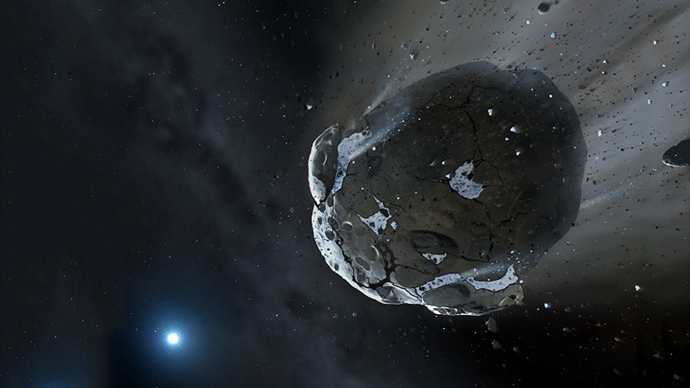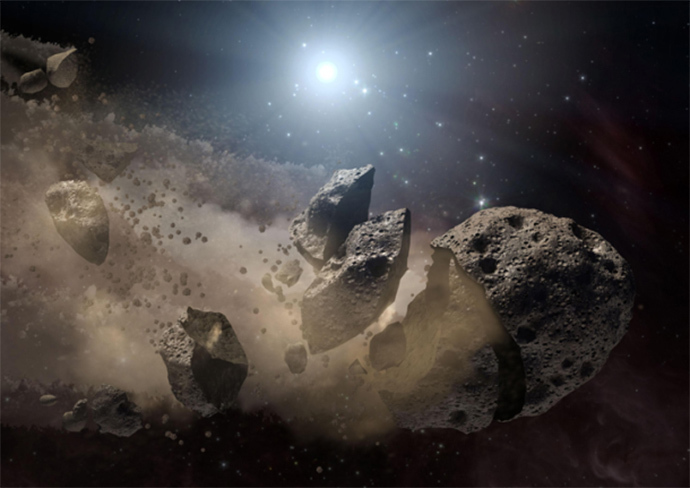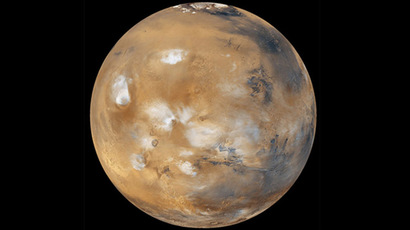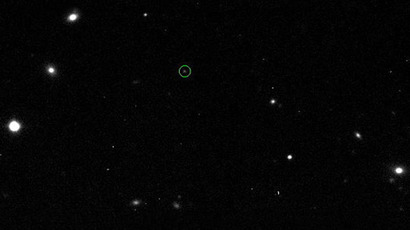Life-sparking ‘wet asteroid’ debris found orbiting white dwarf

Scientists have detected the first ever water-heavy asteroid – of the kind that is thought to have brought water to Earth – outside our solar system. The discovery reinforces astronomers’ belief that there may be more habitable worlds in the universe.
The asteroid, of which only remnants now exist, was discovered
with the help of space forensics and deduction outside GD 61, an
extinguished sun 170 light years away from our planet.
Teams from Cambridge, Warwick and Kiel universities used the Hubble Space Telescope to observe the white dwarf, a sun that has used up its energy and has decreased to a small but dense body, comparable to the size of the Earth but with an enormous mass of a star.
As the sun was shrinking, its gravity pulled in and crushed parts of its solar system. Around GD 61 a layer of pollution has formed that consists of elements too light to be dragged to the surface of the white dwarf, and it is the composition of this pollution that gave the scientists the idea that a ‘wet asteroid’ once existed in its system.
Among the pollution a high percentage of oxygen was detected, and
the only explanations the scientists posited were either dry ice
or water, and further measurements left only the last option.

The astronomers calculated that the asteroid consumed by GD 61 was at least 90 km across and contained 26 percent water. A similar asteroid crashing down on a previously dry Earth is suspected by some scientists to have kick-started life on our planet (which is incidentally only 0.02 percent composed of water).
“The finding of water in a large asteroid means the building blocks of habitable planets existed, and maybe still exist, in the GD 61 system,” said Jay Farihi, from the Cambridge Institute of Astronomy. “A system cannot create things as big as asteroids and avoid building planets, and GD 61 had the ingredients to deliver lots of water to their surfaces.”
It is impossible with current technology to definitively say whether actual planets, and water-filled ones also existed in the GD 61 system, but in about 6 billion years, the image of our solar system would not look much different from it. When our sun also expends its nuclear fuel and turns into an all-devouring white dwarf, Earth may or may not be far enough to resist its pull.
More than 1,000 planets and several thousand candidates have been discovered by astronomers outside our solar system, though it is hard to say how many of them have correct conditions to be habitable. And looking at our solar system billions of years later, alien astronomers could be getting the same proof of alien life existence.
“I think alien astronomers would at that point be getting pretty similar information to what we're getting on GD 61,” Dr Farihi explained. “I guess it would depend on what time they looked and which asteroid they were lucky enough to catch. But we know of water-rich asteroids in the outer main belt and I think there would be a good chance that they would see a signature of something like the asteroid Ceres.”
“And in that case, if the alien astronomers speculated about habitable planets – well, if they're looking back at our system, in that case they'd be correct,” he added.















